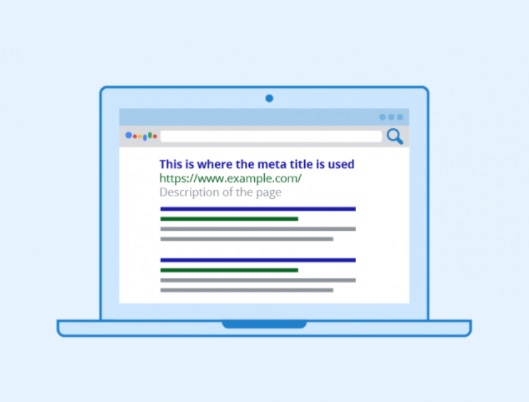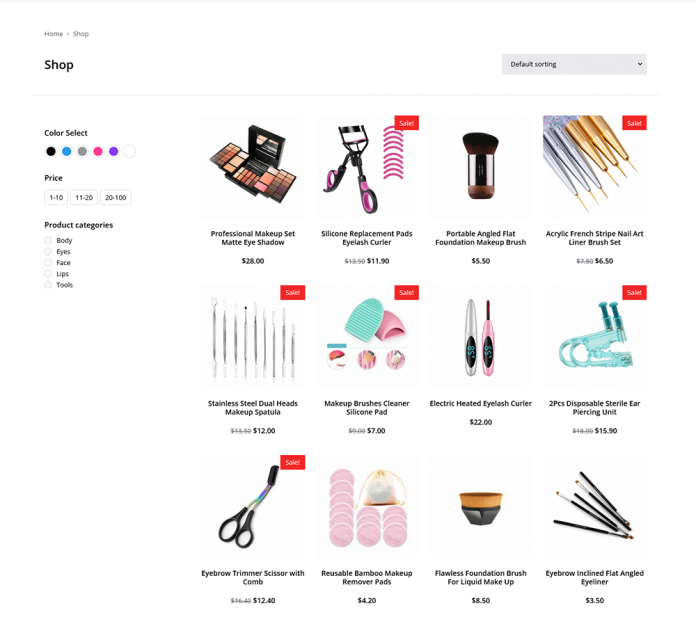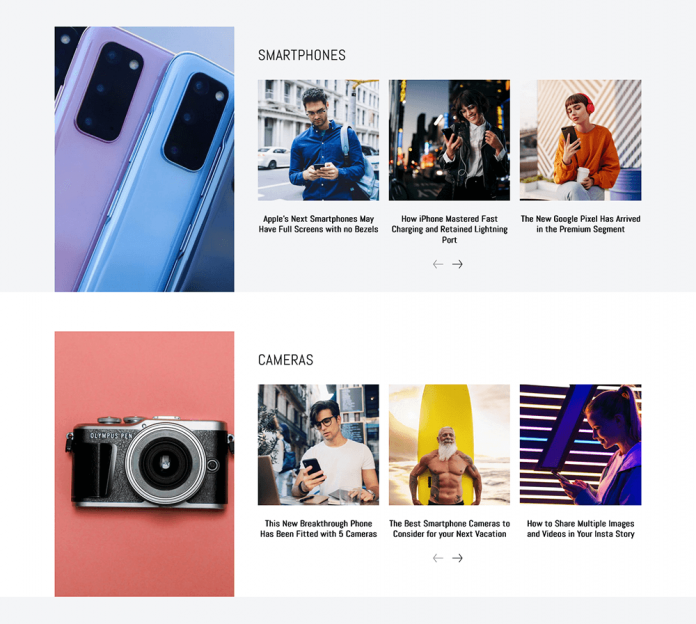Definition of meta title
A meta title (also known as a title tag) is an element in an HTML document’s head section that defines the title of each page of a website. Web browsers retrieve it, and search engines such as Google utilize it to display a webpage in search results (SERPs). The meta title is frequently mislabeled as a meta tag. However, this is incorrect because it is a distinct HTML element.

SEO Importance (Meta title)

The title tag is an important factor for Google in determining the relevancy of a website to a specific search query. Keywords used in the meta title are especially important for the ranking of a webpage. As a result, optimizing meta titles is one of the most significant SEO jobs, with a big impact achievable with minimal work. As a result, the meta title is regarded as one of the low-hanging fruits of search engine optimization (SEO).
Furthermore, the wording and content of the title frequently determine whether a user clicks on a Google search result or not, because he identifies what the page is about and whether it is relevant to him based on the title. As a result, the title can considerably enhance a website’s click-through rate (CTR) in the SERPs, which is also beneficial to its SEO.
How to Improve Your Meta Title
There are some formal and content-related elements to consider while improving the title element.
When it comes to the length of your meta titles, keep in mind that Google only uses 580 pixels to display the meta title of a webpage in search results, which translates to about 70 characters (including spaces). This amount should not be surpassed because Google will otherwise cut off the title. Your meta title should be between 55 and 65 characters long. You can simply check if your meta title exceeds this recommended length using the Seobility SERP Snippet Generator:

In terms of content, the title tag should include the most significant keywords for your website’s SEO. Instead of overloading your title with keywords, blend them into a coherent sentence. Otherwise, it may be penalized by search engines due to “keyword stuffing.” Furthermore, the most significant keyword should always come first, as Google places a high value on the first word of the title. A total of four keywords may be utilized. It is best to avoid word repeats and spelling mistakes. Furthermore, if the title contains multiple terms, they should be separated by a vertical line “|” rather than a hyphen. This permits the title to be displayed more prominently on the search results pages.
Furthermore, your meta title should provide users with a succinct, concise, and understandable summary of what the page is about and why it is relevant to them. Terms like “Welcome” or “Home” should be avoided because they don’t convey any information about the page’s content. Furthermore, in order to enhance your click-through rate, your title should be engaging to users. As a result, especially online stores should use call-to-actions and underline the distinctiveness of their own offer in comparison to competitors.
If no meta title is supplied, or if it is insufficiently informative, Google may generate a title for your webpage based on the content of that page. Because this does not always produce positive results, it is critical to set a meta title for each page of a website. You can quickly verify which of your pages have missing or faulty Meta Titles on the HTML Improvements page in Search Console. Google has been changing more page names in search results since August 2021 if they do not fulfill Google’s quality requirements. Titles that are too long, generic titles, keyword stuffing, and so on are examples of this. Google uses other page elements, such as heading tags, to build new titles.
Overall, each meta title should be used just once on your website because it should reflect the unique content of each page. You can ensure that individual subpages rank high for certain search keywords in this manner. If you use the same meta title for each subpage of a site instead, you’ll lose a lot of SEO potential because Google normally only displays one page from a domain in the results for a specific search query. You can also have your meta titles generated automatically if you have a large website. However, you should make sure that these titles are unique to each page.
The following are the most significant elements to consider while optimizing your meta titles:
- The ideal length is between 55 and 65 characters (maximum 70)
- Combine important keywords into a meaningful statement, with the
- most important term coming first.
- Avoid word repeats and spelling mistakes.
- use a call-to-action if necessary provide a clear and understandable summary of the page content
- use individual titles for each page of a website
Examples of both good and poor
Here’s a good example of a meta title by Time Out that appears when you search for “affordable restaurants London”:

This title is of reasonable length and describes the page’s content in a succinct and accessible manner. Furthermore, it is written in an appealing manner.
The following result for the search term “black shoes” can also be used as an example:

This meta title is also of sufficient length, so it is not truncated by Google. Furthermore, all major keywords are included, with the most relevant ones (“black shoes”) appearing first. This headline seems intriguing, and the addition of “Athletic & Casual” encourages consumers to click on it.
On the other hand, the following page title can serve as a bad example:

First and foremost, this title is too long and is thus cut off by Google. Furthermore, the phrase “black shoes” appears three times. This takes up a lot of room, which could be used to create a more appealing meta title.
Best way to improve CTR 2022
Improving your website’s CTR is simple if you follow the appropriate procedures. So, begin by following the practical steps below, but keep in mind that you may need to modify them to meet your specific circumstances. Because every site is unique, you should alter your technique until you see an increase in viewership.
1: Determine your website’s click-through rate (CTR).
The first step in creating a successful marketing strategy is to assess the existing state of your website and any activity on it. Depending on how users arrive at your website, there are a few ways to assess your current CTR.
If you’re using Google Ads, all you have to do is a glance at your ad campaign reports. Adding Google Analytics to your website will also allow you to track how many people visit your site as a result of those adverts. To assist with reporting, I recommend installing a WordPress analytics plugin.
While Google Analytics is free and provides detailed data, it is also difficult to set up and read if you are not an expert. A good plugin will provide you with the necessary visual data by displaying the most critical information on your dashboard.
Another approach to assess your CTR is to examine conversions. When someone visits your website, do they sign up for your newsletter or purchase your product? This information indicates that people are clicking on your ad and website link on SERPs. However, it also goes a step further and proves that your content is effective by converting visitors from leads to purchasers.
2: Boost Your Search Engine Positioning
Here are two important ranking statistics to be aware of:
- Seventy-five percent of searchers do not get past the second page of search engine results.
- The first five search results receive 67% of all clicks
These statistics reveal a crucial fact: the higher your content ranks for a term, the more clicks you receive. As a result, you must prioritize search engine optimization in your marketing efforts.
We can’t cover SEO in depth in this piece, but the following points will give you a decent understanding of what you need to do to improve your site’s rankings:
- Understand your target audience. You can select the proper keywords and generate content that is relevant to your audience after you understand what they want and who they are.
- Make use of SEO tools. A decent SEO tool will scan your website, discover issues, analyze your competition, and suggest keywords to target. The greatest way to improve the performance of your website is to use data offered by an SEO tool.
- Make stuff that is useful. This should go without saying, but many companies make the mistake of relying solely on promotional content. Instead, consider the issues that your clients encounter and create blog pieces that provide solutions. Truly useful information has a better probability of being ranked as a top post.
- Perform technical SEO. There is a technical side to SEO that you must not overlook. You must generate sitemaps, configure your robots.txt file to allow search engines to crawl your site, and perform other technical activities that are best accomplished with the help of an SEO plugin.
The goal of SEO is to develop content and structure your website in order to give the best possible experience for your audience.

Make sure you’re using a complete SEO plugin or program. I propose using AIO SEO, which allows you to manage your SEO efforts directly from your WordPress dashboard.
3: Make your titles more appealing
Obtaining a higher position for your website’s content isn’t enough. Before they click on your link, people must believe that your website has the best potential of addressing their demands.
They read the search result titles to see which post is most likely to provide the answer they need. So, improving your post and page titles is a simple but crucial component in your rankings. Here’s how it works:
- Make use of a headline analyzer tool. This type of tool will provide you with a score and inform you whether your post titles are more likely to generate clicks and lead to higher search rankings. Rewrite your titles until they receive a 70 or above.
- Make your titles informative. They should explain to your readers exactly what your piece is about and what they may expect. The phrase “7 Best Adventure Motorcycle Boots for Trail Riding” is superior to “7 Best Motorcycle Boots.”
- Stay away from clickbait. When visitors click on such information and discover that it isn’t what they expected, it creates a negative user experience, and your website will be punished by search engines as a result of the high bounce rate that results.
- Also, avoid using long titles. Users want their information as soon as possible. A title that is brief and detailed is easier to read and informs your readers of everything they need to know in an instant. Furthermore, meta descriptions that are too long will be truncated by most search engines.
4: Make use of meta descriptions
Before clicking on any links, people look through meta descriptions to learn more about the content of a website. In your search page result, meta descriptions show underneath a URL and display a few lines of text that describe the content therein.
While meta descriptions do not have a direct impact on your website’s ranking, they do have an impact on user behavior. A well-written and interesting description will persuade people to choose your link over another. Such activity is observed by search engines such as Google and is taken into account when ranking websites.
Here are some tips for improving your meta description to get more clicks:
- Use keywords. Including relevant keywords in your meta description informs people that your material is for them, increasing the likelihood that they will click on your URL.
- Be descriptive. Your meta description, like your titles, should clearly convey what your website is about.
- Add a call to action. You can utilize this area to compel users to take immediate action. Including a call to action also implies to users that your page would assist them in achieving their aims straight away.
- Establish trust. Depending on the nature of your material, the meta description is an excellent location to establish trust. Mention any accolades you’ve received, the number of downloads you’ve received, and other trust elements that will persuade users of your genuineness.
When done correctly, meta descriptions add context and assist users in determining whether your website is appropriate for them. They can boost your CTR and bring qualified leads to your company.
5: Make use of structured data
If you’ve ever searched for a recipe online, you’ll notice that Google returns results that include the cooking time, recipe ratings, and other details for each site that appears on the results page.
This data appears as a result of the use of structured data or schema markup. Structured data for SEO is coding that you may add to your website content to help search engines better understand it.
There is schema markup for books, movies, and other creative works. Structured data can also be included for places such as businesses, local retailers, and restaurants. As a result, when individuals search for a business online, they will find ratings, prices, and other information.
Using schema markup increases the likelihood that search engines will display your website for specific searches. They also give users enough information at a glance to determine whether your content is appropriate for their needs. Such additional information will go a long way toward attracting traffic to your company’s website.
6: Make Use of Ads
We’ve looked at a number of organic techniques to increase your CTR. However, it is also a good idea to use paid choices such as advertising. Use Google Ads’ Keyword Planner tool to find keywords with enough volume but not too much competition.
If you’re not careful with your ad spending, you can soon rack up a bill. That being said, using paid advertisements to promote your website to the top of a page can help you fast gain a large increase in traffic.
Paying for advertisements is a worthwhile activity that aids in the development of your brand’s image. It also allows you to see how people react to your content and whether or not you can drive conversions.
Read More: How to earn money without work in 2022?






